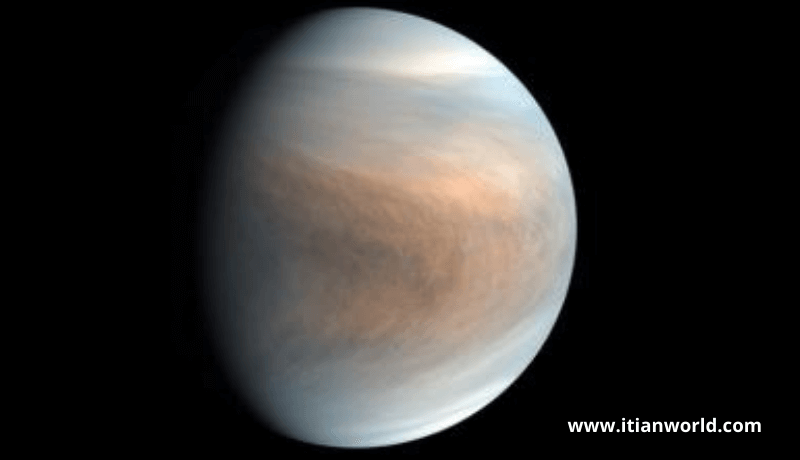

Date: September 18, 2020
Source:
Materials gave by ESO.
A worldwide group of space experts today reported the disclosure of an uncommon particle - phosphine - in the billows of Venus. On Earth, this gas is just made mechanically or by organisms that flourish in sans oxygen conditions. Space experts have estimated for quite a long time that high mists on Venus could offer a home for microorganisms - coasting liberated from the burning surface however expecting to endure exceptionally high acridity. The recognition of phosphine could highlight such extra-earthbound 'ethereal' life.
"At the point when we got the primary traces of phosphine in Venus' range, it was a stun!," says group pioneer Jane Greaves of Cardiff University in the UK, who first spotted indications of phosphine in quite a while from the James Clerk Maxwell Telescope (JCMT), worked by the East Asian Observatory, in Hawai'i. Affirming their disclosure required utilizing 45 radio wires of the Atacama Large Millimeter/submillimeter Array (ALMA) in Chile, a more touchy telescope where the European Southern Observatory (ESO) is an accomplice. The two offices watched Venus at a frequency of around 1 millimeter, any longer than the natural eye can see - just telescopes at high height can recognize it viably.
The worldwide group, which incorporates scientists from the UK, US and Japan, assesses that phosphine exists in Venus' mists at a little focus, just around twenty atoms in each billion. Following their perceptions, they ran computations to see whether these sums could emerge out of common non-natural cycles on the planet. A few thoughts included daylight, minerals blown upwards from the surface, volcanoes, or lightning, yet none of these could make anyplace approach enough of it. These non-organic sources were found to make all things considered one ten thousandth of the measure of phosphine that the telescopes saw.
To make the watched amount of phosphine (which comprises of hydrogen and phosphorus) on Venus, earthly creatures would just need to work at about 10% of their greatest profitability, as indicated by the group. Earth microscopic organisms are known to make phosphine: they take up phosphate from minerals or natural material, include hydrogen, and at last remove phosphine. Any creatures on Venus will most likely be totally different to their Earth cousins, however they also could be the wellspring of phosphine in the climate.
While the revelation of phosphine in Venus' mists came as a shock, the analysts are certain about their discovery. "To our incredible help, the conditions were acceptable at ALMA for follow-up perceptions while Venus was at a reasonable point to Earth. Preparing the information was dubious, however, as ALMA isn't typically searching for exceptionally unpretentious impacts in extremely brilliant items like Venus," says colleague Anita Richards of the UK ALMA Regional Center and the University of Manchester. "At long last, we found that the two observatories had seen something very similar - swoon assimilation at the correct frequency to be phosphine gas, where the atoms are illuminated by the hotter mists beneath," includes Greaves, who drove the examination distributed today in Nature Astronomy.
Another colleague, Clara Sousa Silva of the Massachusetts Institute of Technology in the US, has researched phosphine as a "biosignature" gas of non-oxygen-utilizing life on planets around different stars, since typical science makes such an insignificant slice of it. She remarks: "Discovering phosphine on Venus was a surprising reward! The revelation brings up numerous issues, for example, how any living beings could endure. On Earth, a few organisms can adapt to up to about 5% of corrosive in their condition - however the billows of Venus are primarily made of corrosive."
The group accepts their disclosure is critical on the grounds that they can preclude numerous elective approaches to make phosphine, however they recognize that affirming the presence of "life" needs much more work. In spite of the fact that the high billows of Venus have temperatures up to a wonderful 30 degrees Celsius, they are unimaginably acidic - around 90% sulphuric corrosive - presenting significant issues for any organisms attempting to make due there.
ESO cosmologist and ALMA European Operations Manager Leonardo Testi, who didn't partake in the new examination, says: "The non-organic creation of phosphine on Venus is barred by our present comprehension of phosphine science in rough planets' environments. Affirming the presence of life on Venus' climate would be a significant achievement for astrobiology; consequently, it is fundamental to catch up on this energizing outcome with hypothetical and observational investigations to bar the likelihood that phosphine on rough planets may likewise have a substance birthplace unique in relation to on Earth."
More perceptions of Venus and of rough planets outside our Solar System, incorporating with ESO's prospective Extremely Large Telescope, may help accumulate pieces of information on how phosphine can begin on them and add to the quest for indications of life past Earth.
This examination was introduced in the paper "Phosphine Gas in the Cloud Decks of Venus" to show up in Nature Astronomy.
The group is made out of Jane S. Greaves (School of Physics and Astronomy, Cardiff University, UK [Cardiff]), Anita M. S. Richards (Jodrell Bank Center for Astrophysics, The University of Manchester, UK), William Bains (Department of Earth, Atmospheric, and Planetary Sciences, Massachusetts Institute of Technology, USA [MIT]), Paul Rimmer (Department of Earth Sciences and Cavendish Astrophysics, University of Cambridge and MRC Laboratory of Molecular Biology, Cambridge, UK), Hideo Sagawa (Department of Astrophysics and Atmospheric Science, Kyoto Sangyo University, Japan), David L. Clements (Department of Physics, Imperial College London, UK [Imperial]), Sara Seager (MIT), Janusz J. Petkowski (MIT), Clara Sousa-Silva (MIT), Sukrit Ranjan (MIT), Emily Drabek-Maunder (Cardiff and Royal Observatory Greenwich, London, UK), Helen J. Fraser (School of Physical Sciences, The Open University, Milton Keynes, UK), Annabel Cartwright (Cardiff), Ingo Mueller-Wodarg (Imperial), Zhuchang Zhan (MIT), Per Friberg (EAO/JCMT), Iain Coulson (EAO/JCMT), E'lisa Lee (EAO/JCMT) and Jim Hoge (EAO/JCMT).
A join paper by some of colleagues, named "The Venusian Lower Atmosphere Haze as a Depot for Desiccated Microbial Life: A Proposed Life Cycle for Persistence of the Venusian Aerial Biosphere," was distributed in Astrobiology in August 2020. Another related examination by a portion of similar creators, "Phosphine as a Biosignature Gas in Exoplanet Atmospheres," was distributed in Astrobiology in January 2020.
Story Source:
Materials gave by ESO. Note: Content might be altered for style and length.


